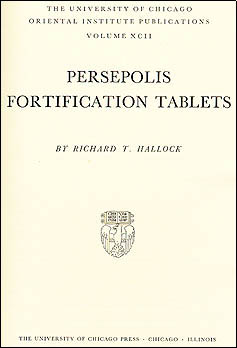OIP 92. Persepolis Fortification Tablets R. T. Hallock

With over 2100 texts published, the Persepolis Fortification Texts in Elamite, transcribed, interpreted, and edited by the late Richard Hallock, already form the largest coherent body of material on Persian administration available to us; a comparable, but less legible, body of material remains unpublished, as does the smaller group of Aramaic texts from the same archive. Essentially, they deal with the movement and expenditure of food commodities in the region of Persepolis in the fifteen years down to 493. Firstly, they make it absolutely clear that everyone in the state sphere of the Persian economy was on a fixed ration-scale, or rather, since some of the rations are on a scale impossible for an individual to consume, a fixed salary expressed in terms of commodities. The payment of rations is very highly organized. Travelers along the road carried sealed documents issued by the king or officials of satrapal level stating the scale on which they were entitled to be fed. Tablets sealed by supplier and recipient went back to Persepolis as a record of the transaction. Apart from a few places in Babylonia for short periods, Persepolis is now the best-documented area in the Achaemenid empire. What generalizations or other insights this provides for other areas is perhaps likely to remain one of the main methodological problems for Achaemenid scholarship. [From an article by D. M. Lewis, "The Persepolis Fortification Texts," in Achaemenid History IV: Centre and Periphery, Proceedings of the Groningen 1986 Achaemenid History Workshop, edited by Heleen Sancisi-Weerdenburg and Amélie Kuhrt (Leiden: Nederlands Instituut voor het Nabije Oosten, 1990), pp. 2-6].
- Oriental Institute Publications 92
- Chicago: The University of Chicago Press, 1969
- ISBN 0-226-62195-2
- Pp. x + 776; no illustrations
- Clothbound 9 x 11.75 in / 23 x 30 cm
- Out of Print

